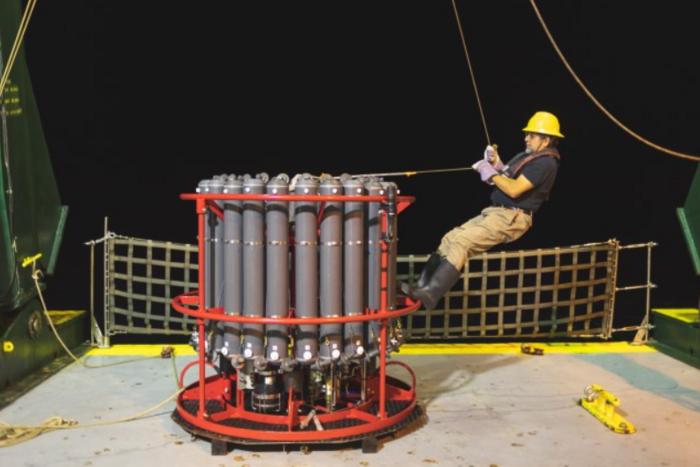In the vast expanse of the North Pacific Ocean, a seemingly invisible force linked to human industry is reshaping the delicate marine ecosystems in ways scientists are only beginning to understand. A recent experimental study led by oceanographers at the University of Hawai‘i at Mānoa has illuminated how anthropogenic—human-derived—iron emissions are altering the natural rhythms of phytoplankton blooms in the North Pacific Transition Zone, a crucial ecological boundary known for sustaining rich fisheries. Published in the Proceedings of the National Academy of Sciences, this research underscores the profound and far-reaching impacts of industrial pollution on ocean biogeochemistry and marine life thousands of miles from the emission sources.
Phytoplankton form the microscopic foundation of marine food webs, relying on nutrients such as nitrogen, phosphorus, and trace metals, notably iron, to fuel photosynthesis and growth. In marine environments, iron is often a limiting nutrient; its availability directly influences the magnitude of phytoplankton blooms. This new study emphasizes the role of iron not just as a naturally occurring element but as a pollutant introduced into the atmosphere through industrial processes—primarily coal combustion and steel production—that subsequently deposits iron particles into the ocean via atmospheric transport.
The North Pacific Transition Zone is a dynamic oceanographic region that demarcates nutrient-poor subtropical gyres to the south from nutrient-rich, temperate ecosystems to the north. It acts as a biogeochemical watershed, influencing regional productivity and the distribution of marine organisms. Until now, while industrial iron had been detected in this area, its effects on phytoplankton productivity and nutrient cycling were poorly understood. This new research bridges that knowledge gap by integrating isotopic fingerprinting of iron, oceanographic sampling, and phytoplankton growth analyses to reveal how industrial iron inputs modulate ecological patterns on a seasonal basis.
Using a series of four oceanographic expeditions aboard the University of Hawai‘i Research Vessel Kilo Moana, scientists collected water and phytoplankton samples throughout different seasons to capture the evolution of iron concentration and biological response. Crucially, the team employed isotopic analyses to distinguish between natural iron sources and iron with an isotope signature indicative of anthropogenic origin. This approach allowed the researchers to trace the industrial iron deposited over 3,000 miles from its emission points.
The findings reveal a compelling seasonal narrative. During spring, phytoplankton in the Transition Zone are typically iron-starved, limiting the scope of the seasonal bloom. The influx of industrial iron supplements this deficit, triggering a more vigorous spring phytoplankton bloom. However, this accelerated bloom creates a complex cascade of ecological consequences. The rapid bloom consumes other essential macronutrients such as nitrogen and phosphorus more rapidly, precipitating a premature collapse of phytoplankton populations later in the season. This boom-and-bust cycle redraws the biogeochemical landscape, with potential ramifications for the higher trophic levels dependent on these primary producers.
Beyond the immediate nutrient dynamics, the study highlights how anthropogenic iron deposition influences the geographical boundaries of ocean ecosystems. The North Pacific Transition Zone serves as an invisible frontier that many marine organisms use as habitat separators. Increased iron input acts not only to stimulate biological productivity but also appears to be shifting this boundary northward. This movement coincides with ocean warming trends, suggesting a complex interplay between pollution-driven nutrient enrichment and climate change-driven habitat displacement.
Nick Hawco, the lead author and assistant professor in the Department of Oceanography at UH Mānoa, interprets these findings as a "one-two punch" on local marine ecosystems: anthropogenic iron disrupts the base of the food web by altering nutrient cycles, while ocean warming pushes productive zones away from important fishing grounds near Hawai‘i. This double stressor threatens the stability and productivity of fisheries and the broader marine food web that coastal communities rely upon economically and culturally.
The technical analysis and high-resolution isotopic measurements conducted in this study demonstrate the unexpected scale over which human industrial activities influence remote marine environments. Iron particles are transported over vast distances through the atmosphere, deposited via precipitation, and subsequently affect ocean chemistry and biology. This complex biogeochemical cycling, interlinking terrestrial industry with ocean ecosystems, poses challenges for current models predicting ocean productivity and carbon cycling.
Looking ahead, the research team is innovating new monitoring techniques to assess iron nutrition in ocean plankton more accurately. By developing robust indicators of iron stress and uptake, scientists can better quantify how fluctuations in iron sources—both natural dust inputs and anthropogenic emissions—impact phytoplankton physiology and distribution. These advancements have important implications for forecasting ecosystem responses to environmental changes and for devising mitigation strategies.
This study exemplifies the intricate connections between human industrial activity and ocean health, demonstrating that even trace metals emitted as pollutants can significantly disturb the foundational processes that sustain marine food webs. Given the critical role phytoplankton play in global carbon cycling and oxygen production, these findings carry ramifications not only for local fisheries but also for broader climatic and ecological systems.
In summary, the infusion of industrial iron into the North Pacific Transition Zone is an unanticipated driver of ecological change, enhancing spring phytoplankton blooms but ultimately destabilizing nutrient dynamics and shifting biological boundaries. These revelations emphasize the urgent need to consider trace metal pollution within the broader narrative of anthropogenic impacts on ocean systems, linking air quality, industrial emissions, and marine ecosystem health in a global context.
Subject of Research: Oceanic impacts of anthropogenic iron deposition on phytoplankton blooms in the North Pacific Transition Zone
Article Title: Anthropogenic iron alters the spring phytoplankton bloom in the North Pacific Transition Zone
News Publication Date: 2-Jun-2025
Web References:
http://dx.doi.org/10.1073/pnas.2418201122
Image Credits: Ryan Tabata
Keywords: Anthropogenic iron, phytoplankton bloom, North Pacific Transition Zone, oceanography, marine ecosystems, biogeochemical cycling, iron isotopes, industrial pollution, primary productivity, ocean warming




